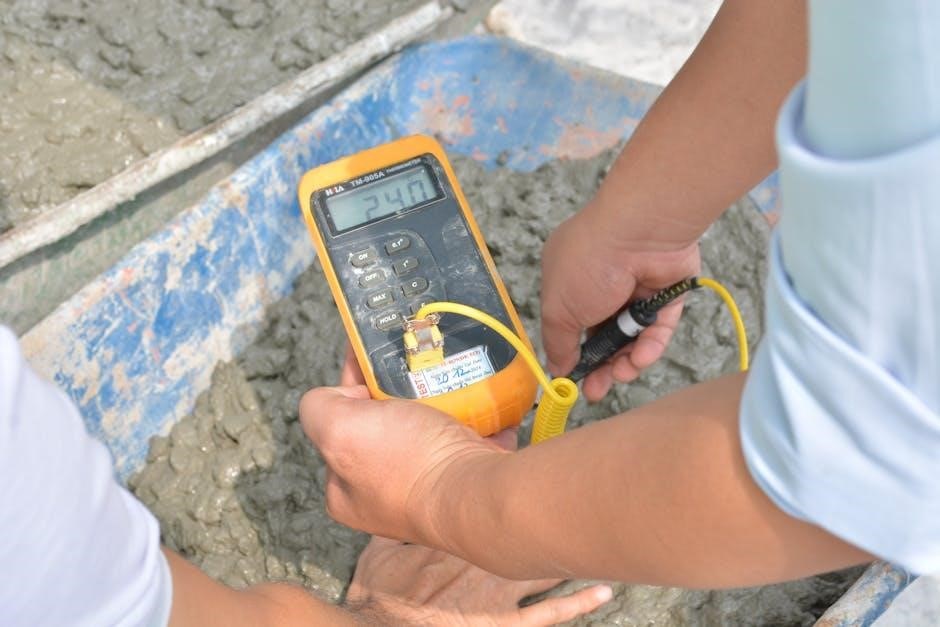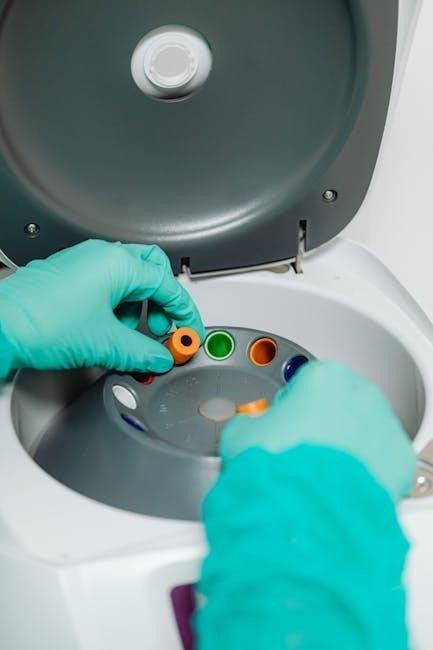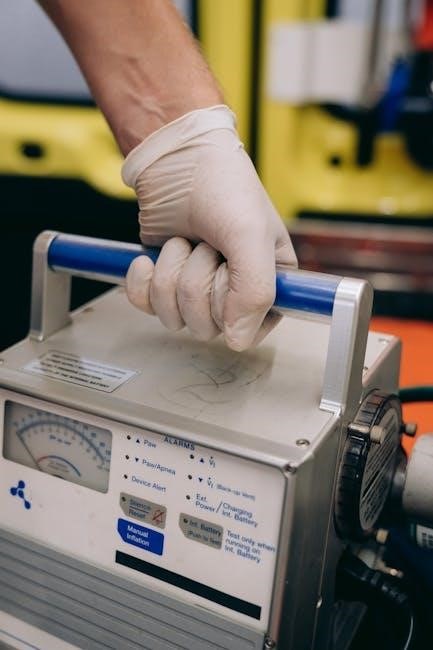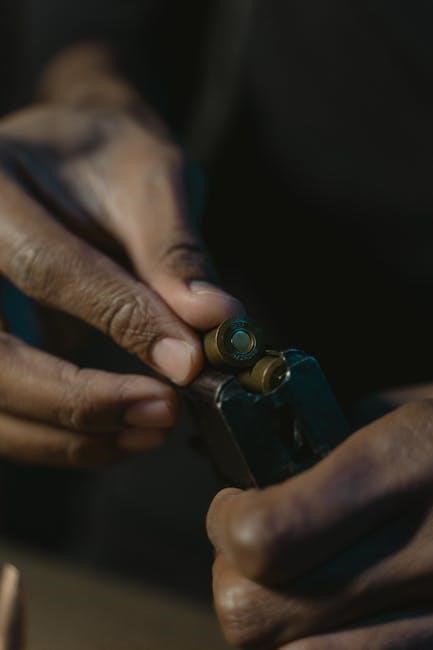This manual provides comprehensive guidance for using Safety 1st thermometers, ensuring accurate readings and safe operation. It covers setup, maintenance, and troubleshooting for optimal performance.
Overview of the Safety 1st Thermometer
The Safety 1st Thermometer is a reliable and versatile device designed for accurate temperature measurement in infants and adults. Available in various models, including forehead, ear, and 3-in-1 (oral, rectal, underarm) options, it offers convenience and precision. Many models feature fever alarms, memory storage for previous readings, and ergonomic designs for comfort. The thermometers are equipped with advanced technology, such as infrared sensors for quick and non-invasive measurements. Safety 1st thermometers are known for their ease of use, durability, and adherence to safety standards, making them a trusted choice for parents and healthcare professionals. They often include additional features like long-life batteries and protective storage cases, ensuring optimal performance and longevity.
Importance of Using the Manual
Using the Safety 1st Thermometer manual is crucial for ensuring accurate temperature readings and safe operation. The manual provides essential guidelines for setup, usage, and maintenance, helping users avoid common errors. It outlines specific instructions for different thermometer types, such as forehead, ear, and 3-in-1 models, ensuring proper technique. Additionally, the manual highlights safety precautions to prevent misuse and potential harm. By following the manual, users can extend the product’s lifespan and maintain hygiene standards. It also serves as a troubleshooting guide, addressing common issues and offering solutions. Adhering to the manual’s instructions ensures reliable performance and optimal results, making it indispensable for both parents and healthcare professionals.

Types of Safety 1st Thermometers
Safety 1st offers a variety of thermometers, including forehead, ear, and 3-in-1 models, each designed for ease of use and accuracy in temperature measurement.
Safety 1st Forehead Thermometer
The Safety 1st Forehead Thermometer is a popular choice for its non-invasive and quick measurements. It uses infrared technology to scan the forehead, providing fast and accurate readings. The device is designed for comfort and hygiene, making it ideal for use on infants and children; Features include a fever alarm, memory storage for previous readings, and a large digital display. The thermometer is easy to use, with clear instructions provided in the manual. It also comes with a storage case to protect the device when not in use. Regular cleaning and proper handling are recommended to maintain accuracy and longevity.
Safety 1st Ear Thermometer
The Safety 1st Ear Thermometer is designed for quick and accurate temperature readings, making it ideal for use on both children and adults. It utilizes infrared technology to measure body temperature through the ear canal, providing results in seconds. The device features a gentle design to ensure comfort during use. A fever indicator alerts users to elevated temperatures, while memory storage allows for tracking previous readings. The manual emphasizes proper positioning and calibration for accurate results. Regular cleaning of the lens and replacing the lens filter when necessary are recommended to maintain performance. The thermometer is user-friendly, with clear instructions provided in the manual to guide first-time users. It is a reliable choice for families seeking a fast and precise method for monitoring body temperature.
Safety 1st 3-in-1 Thermometer (Oral, Rectal, Underarm)
The Safety 1st 3-in-1 Thermometer offers versatile use for oral, rectal, and underarm temperature measurement, making it a practical choice for families. Its flexible tip enhances comfort, especially for rectal use, while the over-insertion gauge ensures safe application. The thermometer provides fast readings and beeps once the highest temperature is recorded. It includes a protective storage case and a long-lasting battery for convenience. The manual outlines specific guidelines for each mode, emphasizing proper hygiene and care. Regular cleaning with alcohol wipes and proper storage are recommended to maintain accuracy and longevity. This multi-functional design allows parents to choose the most comfortable method for their child, ensuring reliable temperature monitoring in various situations.

Safety Instructions for Using the Thermometer
Always supervise children, avoid letting them play with the device, and clean the thermometer with alcohol wipes after use. Store it in a protective case when not in use.
General Safety Guidelines

Always supervise children when using the thermometer to ensure safe operation. Avoid letting children play with the device, as it is not a toy. Clean the thermometer with alcohol wipes before and after each use to maintain hygiene. Store the thermometer in its protective case when not in use to prevent damage. Follow the specific precautions for your thermometer type, such as avoiding extreme temperatures or improper handling. Keep the thermometer out of reach of children to prevent accidental misuse. Regularly check the device for any damage or wear and tear, and replace it if necessary. Adhere to the manufacturer’s instructions for battery replacement and maintenance to ensure accurate readings and longevity of the product. By following these guidelines, you can ensure safe and effective use of your Safety 1st thermometer.
Specific Precautions for Different Thermometer Types
For forehead thermometers, ensure the device is held at the correct distance and angle to avoid inaccurate readings. Avoid using forehead thermometers on sweaty skin or in direct sunlight. Ear thermometers require proper positioning in the ear canal; consult the manual for guidance. For 3-in-1 thermometers, use the correct mode for oral, rectal, or underarm measurements. Always sanitize the probe between uses, especially when switching between rectal and oral modes. Avoid sharing thermometers to prevent cross-contamination. Store each type in its protective case to prevent damage. Follow specific cleaning instructions for each thermometer type, as improper cleaning may affect accuracy. Adhere to these precautions to ensure safe and reliable temperature measurements.
Handling and Storage Tips
Always handle the thermometer with clean, dry hands to prevent contamination. Store the device in its protective case when not in use to avoid damage. Keep it away from direct sunlight, moisture, and extreme temperatures. For thermometers with batteries, ensure they are securely stored and replaced correctly to maintain functionality. Clean the device regularly as per the manual’s instructions, using mild soap and water. Avoid submerging the thermometer in water unless specified as waterproof. Store extra batteries in a cool, dry place, away from children. Properly dispose of old batteries according to local regulations. By following these tips, you can extend the lifespan and ensure the accuracy of your Safety 1st thermometer.

User Guide for the Safety 1st Thermometer
This guide provides step-by-step instructions for setting up, using, and maintaining your Safety 1st thermometer, ensuring accurate readings and safe operation for all users.
Getting Started: Unpacking and Initial Setup
Unboxing your Safety 1st Thermometer is the first step to ensuring accurate and safe temperature readings. Carefully remove the device from its packaging and inspect for any damage. Insert the provided batteries, ensuring they are correctly oriented and the compartment is securely closed. For models requiring calibration, refer to the specific instructions in the manual. Before first use, perform a test reading to verify functionality. Store the thermometer in a clean, dry place, and keep it out of reach of children. Always follow the manufacturer’s guidelines for setup and operation to ensure optimal performance and safety. Proper initialization guarantees reliable results for years to come.
How to Take Accurate Temperature Readings
To ensure accurate readings, follow the specific guidelines for your Safety 1st Thermometer model. For forehead thermometers, position the device 1-2 inches from the center of the forehead, aligning the red LED dots. Gently press and hold the scan button until the beep sounds. For ear thermometers, insert the probe gently into the ear canal, ensuring it’s straight and not tilted. For oral or rectal use, place the probe under the tongue or rectum, respectively, and wait for the beep. Always clean the thermometer before and after use. Avoid taking readings immediately after feeding, bathing, or intense activity, as this may affect accuracy. Ensure the area is clean and free from obstructions for reliable results; Proper technique is key to obtaining precise temperature measurements.
Troubleshooting Common Issues
If your Safety 1st Thermometer isn’t functioning properly, restart it by removing and reinserting the battery. Ensure the battery is correctly installed and not depleted. For forehead thermometers, check that the lens is clean and free from obstructions. If readings are inconsistent, verify proper positioning and distance from the forehead. For ear thermometers, ensure the probe is securely inserted and free from earwax buildup. If the device still malfunctions, refer to the user manual for reset instructions or contact customer support. Regular cleaning and proper storage can prevent many common issues. Always follow the manufacturer’s guidelines for troubleshooting to maintain accuracy and extend the product’s lifespan. Addressing these issues promptly ensures reliable performance and accurate temperature readings.

Maintenance and Care of the Thermometer
Regularly clean the thermometer with a soft cloth and mild soap solution. Avoid harsh chemicals to prevent damage. Store it in a protective case to maintain accuracy and longevity.
Cleaning the Thermometer
Cleaning your Safety 1st Thermometer is essential for maintaining accuracy and hygiene. Use a soft, dry cloth to wipe down the device, paying attention to the sensor area. For more thorough cleaning, dampen the cloth with mild soap and water, but avoid submerging the thermometer in liquid. Never use harsh chemicals, abrasive materials, or alcohol, as they may damage the device. After cleaning, allow the thermometer to air dry completely before storing it. Regular cleaning ensures reliable readings and prevents the spread of germs. Always refer to the specific cleaning instructions in your manual, as methods may vary slightly depending on the thermometer type. Proper care will extend the lifespan of your Safety 1st Thermometer and ensure it remains a trusted tool for monitoring health.
Replacing Batteries
Replacing batteries in your Safety 1st Thermometer is a straightforward process to ensure continuous operation. First, locate the battery compartment, usually found on the back or bottom of the device. Open it by sliding or unscrewing the cover. Remove the old batteries and insert new ones, making sure to align the positive (+) and negative (-) terminals correctly. Use the battery type specified in your manual, typically LR44 or 1.5V alkaline batteries. Avoid mixing old and new batteries or using rechargeable ones unless stated. After replacing, close the compartment securely. Proper battery replacement ensures accurate readings and extends the product’s lifespan. Always dispose of used batteries safely and recycling when possible. If your thermometer has a low-battery indicator, replace the batteries promptly to maintain functionality. Refer to your manual for specific instructions tailored to your model.

Regular Maintenance Checks
Regular maintenance checks are essential to ensure your Safety 1st Thermometer functions accurately and lasts long. Start by inspecting the device for any visible damage or wear. Clean the thermometer regularly using a soft cloth and mild soap solution to prevent dirt buildup. For digital models, check the battery compartment for corrosion and ensure it’s dry. If your thermometer has a memory feature, periodically review and clear stored readings to maintain performance. Additionally, verify that the device is calibrated correctly by following the manual’s instructions. Always store the thermometer in its protective case when not in use to avoid accidental damage. Regularly updating any software or firmware, if applicable, will also ensure optimal functionality. By performing these checks, you can rely on your thermometer for precise and reliable readings. Proper maintenance also extends the product’s lifespan and ensures safety for repeated use. Always refer to the manual for model-specific tips.

Additional Features of the Safety 1st Thermometer

The Safety 1st Thermometer includes features like fever alarms, memory storage for previous readings, and a backlit display for easy use in low light. Silent mode and adjustable settings enhance convenience.

Unique Features and Benefits
The Safety 1st Thermometer boasts innovative features designed for accuracy and convenience. Its fever alarm alerts users to elevated temperatures, while the memory storage function keeps track of previous readings. The backlit display ensures readability in low-light conditions, and the silent mode prevents disturbing a sleeping child. Certain models include a flexible tip for comfort during oral or rectal use, and some thermometers offer a no-touch forehead scanning option for quick measurements. These features, combined with their ease of use and durability, make Safety 1st thermometers a trusted choice for families. They also come with long-life batteries and storage cases for added convenience, ensuring reliable performance when needed most.
Fever Alarm and Alert Systems
The Safety 1st Thermometer features an advanced fever alarm system designed to notify users of elevated temperatures instantly. This system provides both visual and audible alerts, ensuring parents are immediately informed when a fever is detected. The alarm is programmable, allowing customization of temperature thresholds to suit individual needs. For forehead models, a color-coded display changes to red when a fever is present, while ear thermometers emit a distinct beep. These alerts ensure prompt action can be taken to care for a child, offering peace of mind for parents. The system is particularly useful during nighttime or in noisy environments, ensuring no alert goes unnoticed.
Using the Safety 1st Thermometer Manual ensures safe and effective temperature monitoring. Follow guidelines for accurate readings, proper care, and troubleshooting to maintain reliability and performance over time.
Final Tips for Safe and Effective Use
Always follow the manufacturer’s guidelines for optimal performance. Supervise children during use and ensure the thermometer is clean before and after each use. Replace batteries as instructed to maintain accuracy. Store the thermometer in a protective case to avoid damage. Avoid exposing it to extreme temperatures or moisture. Regularly check for updates or recalls. By adhering to these tips, you can ensure safe, accurate, and long-lasting use of your Safety 1st Thermometer.
